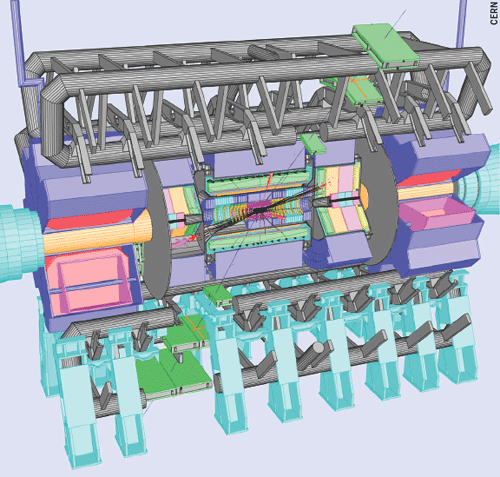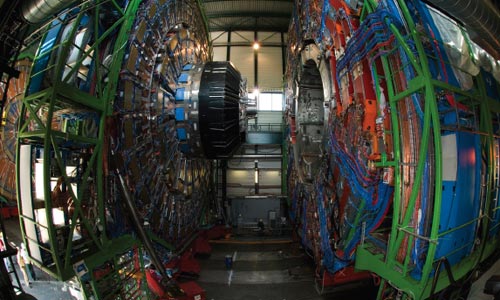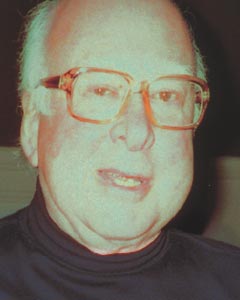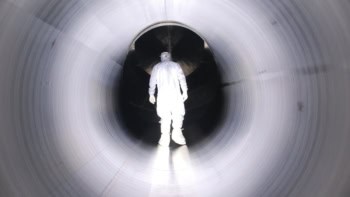Particle physicists hope that the Large Hadron Collider will discover the Higgs boson and the first evidence of physics "beyond the Standard Model". Andy Parker explains how these and other physics goals will be achieved using the giant general-purpose detectors ATLAS and CMS
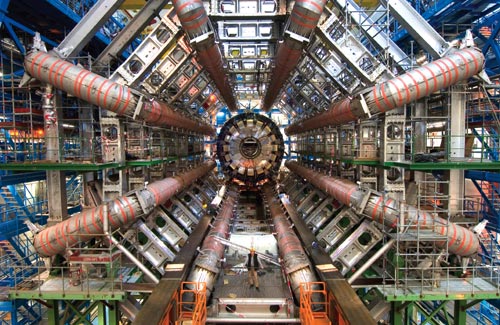
The largest scientific expedition ever mounted is preparing to set out. The team has gathered the best equipment it can muster, debated the challenges it will face, and drafted the most detailed maps it can of the terrain ahead. It aims to explore the “inner space” of matter, thousands of times smaller than a proton. Now, with the world’s most powerful particle accelerator nearing completion at CERN, near Geneva, two decades of planning are about to be put to the test.
The Large Hadron Collider (LHC) will tackle some of the biggest challenges in particle physics. It hopes to find the elusive Higgs boson, supposedly responsible for the masses of all other particles; it may see a “supersymmetric” world, where a myriad of new particles mirror our familiar matter; or it may even find a fifth dimension, curled up into a tiny loop at the heart of the atom. Perhaps most excitingly, it could find something that no-one has yet imagined, explaining at a stroke some of the long-standing questions that our current “Standard Model” of particle physics cannot answer.
To reveal the secrets that lie at the high-energy frontier we need an exceptional machine. Starting next year, protons will be smashed into one another at unprecedented energies of 14 TeV (14 × 1012 electron-volts) at four different points around a 27 km-long circular tunnel deep under the Swiss and French countryside. Some of the quarks and gluons within the protons will collide head on, releasing enough energy to create showers of new particles. And waiting to record the crucial debris from these collisions will be four massive detectors, together employing about 6000 scientists from all over the world.
Of these, it is the two giant all-purpose detectors – ATLAS and CMS – where the main hopes of discovering the Higgs boson lie. The detectors have been designed with that goal very much in mind, but this also puts them in a great position to see a range of brand new physical processes beyond the Standard Model.
A massive problem
The Standard Model of particle physics describes subatomic matter in terms of quarks and leptons, which interact with one another via the strong, weak and electromagnetic forces. These forces are carried by “gauge bosons”: the electromagnetic force by photons; the strong force by gluons; and the weak force by the W and Z bosons. Quarks are affected by the strong force, which binds them together to form “hadrons” such as protons and neutrons that are only 10–15 m across. Leptons, on the other hand, only feel the electromagnetic and weak forces, meaning that electrons, for example, can roam outside atomic nuclei in orbits 10–10 m across. At such tiny scales, there is really no such thing as solid matter: the Standard Model is a “quantum field theory” in which both the particles of matter and the forces between them are described as vibrations of fields in a vacuum.
The great triumph of the Standard Model is that it unites the weak and electromagnetic forces, which behave very differently in everyday “low energy” conditions, into a single electroweak force at high energies. The difference between the electromagnetic and weak forces arises because of their interactions with another quantum field – the Higgs field. These interactions cause the photons of the electromagnetic field to be massless, while the W and Z bosons associated with the weak force have a large mass. Within the Standard Model, the Higgs field is also responsible for giving quarks and leptons their masses, and it is a vibration in the Higgs field that appears as the famous Higgs boson.
Without the Higgs boson, the Standard Model simply does not work; but despite previous experiments confirming the predictions of electroweak unification with great precision, this particle has not yet been discovered. The Standard Model does, however, tell us roughly where we should look for it. By putting the measured masses of the W and Z bosons into the electroweak theory we can calculate that the mass of the Higgs must be less than about 1 TeV/c2.
As the energy of the proton–proton collisions at the LHC will be 14 TeV, it should be easy to produce a particle of this mass. You might imagine, therefore, that finding or ruling out the Higgs is a simple task – turn on the machine, see if a Higgs pops out, then go off to do something else. Unfortunately, life is not so simple.
Even if the Higgs field does exist, it seems to contain the seeds of its own destruction. This is because Higgs bosons must themselves move through the vacuum, interacting with all the fields there, including the Higgs field itself. Theoretical calculations taking into account all these interactions predict a Higgs mass comparable to the “Planck mass” of 1016 TeV/c2, 16 orders of magnitude higher than required by the Standard Model. This huge discrepancy is known as the hierarchy problem, and it leads theorists to conclude that either the Higgs boson does not exist and something else will be found at the TeV energy scale to replace it; or that there is some as-yet unseen effect that modifies the theory to allow the Higgs mass to fall into the TeV range.
Two main ideas have been put forward to solve the hierarchy problem, the most popular of which is supersymmetry (SUSY). In supersymmetric models, the interactions with normal matter that otherwise make the prediction of the Higgs mass comparable to the Planck mass are cancelled out by interactions with previously unseen supersymmetric particles or “sparticles”. SUSY predicts that there are sparticle partners for every type of normal particle, differing in the amount of spin that they carry. For example, electrons and quarks carry half a unit of spin, while their SUSY partners, dubbed selectrons and squarks, carry none. In order to keep the Higgs mass at the TeV scale, the sparticles must themselves have masses of about 1 TeV/c2, and so they too are prime targets for the LHC. Indeed, supersymmetry is regarded as the least surprising type of new physics that could be discovered at the LHC.
The second approach to solving the hierarchy problem is more recent and more outrageous. If the calculations dictate that the Higgs mass is indeed comparable to the Planck mass, then instead of modifying the calculation, why not move the Planck mass down to the TeV scale? The Planck mass is a combination of fundamental constants that effectively sets the strength of gravity, so it seems ridiculous to alter it. But in fact, experiments have only measured gravity over distances longer than about 100 µm. Theorists have thus suggested that there could be extra spatial dimensions below this scale, curled up into tiny loops. Gravity could then be much stronger than we have measured, but with most of it being absorbed into the “invisible” extra dimensions.
Stronger gravity corresponds to a smaller Planck mass, lowering the predicted Higgs mass and thus solving the hierarchy problem. If this radical idea turns out to be correct, the collisions at the LHC will be energetic enough to excite the gravitational field in the extra dimensions, creating observable particles or even tiny black holes.
Reconstructing events
With the Higgs boson, supersymmetric particles and maybe even extra dimensions all predicted to occur at the scale of a few TeV, it is clear why the collisions at the LHC are of such great interest. Currently, the world’s highest energy collisions take place at the Tevatron accelerator at Fermilab in the US, but with its proton–antiproton collisions having energies of 2 TeV, new physics has remained tantalizingly out of reach.
At the LHC, bunches of some 1011 protons at a time will be accelerated to 7 TeV. As the protons approach the detectors, they will be focused by electromagnetic fields to increase the chance of a collision. About 20 protons will collide each time the beams cross, most being glancing blows. But occasionally, two quarks in the incoming protons will meet head on, creating a “hard” collision in which the energy released can create new massive particles, including the Higgs boson and sparticles, if they exist.
The situation is complicated by the fact that we will never observe a Higgs boson or a sparticle directly because they are unstable and decay almost instantly into normal Standard Model particles. Instead, their fleeting existence must be inferred from the decay products that fly outwards from the collision and into the detector. Unfortunately, we do not have much time to do this. Travelling at close to the speed of light, particles pass through the entire ATLAS detector in about 30 ns, with the particles from the next set of collisions following just 25 ns behind. To make matters worse, the debris from each collision will contain 1000 or so particles, each of which must be tracked and measured to try to reconstruct what happened in the original collision, or “event”.
To this end, the huge ATLAS detector – weighing some 7000 tonnes and measuring over 26 m in length and 20 m in diameter – consists of a number of subdetectors, designed to identify and measure different types of particle (figure 1). Three main subsystems, are arranged in cylindrical layers around the vacuum pipe that carries the proton beams: the inner detector is devoted to measuring charged-particle tracks; the calorimeters measure the energy of particles; and the outermost subsystem is used to detect muons. Millions of electronic channels will read out the raw data from the detector systems – the first step in a chain that will allow physicists to deduce what happened in the collisions and hopefully to identify new physical processes.
Storing all the data read out from each of the billion or so collisions every second would be impossible, so the detectors themselves will be programmed to select only the most interesting events. Dedicated electronic “trigger” systems will inspect the data for high-energy deposits or interesting patterns of particles, accepting only about 0.25% of the events. Farms of powerful computers will be used to further process the surviving events, reducing the number passed onto waiting physicists for analysis to a more manageable 100 events per second.
Even after this massive filtering exercise, over a petabyte (1015 bytes, or a million CDs) of data will be recorded each year. Small teams of physicists will work together on their chosen topic, trying to pick out interesting “signal” events such as Higgs decays while removing “background” events that come from known Standard Model processes. In order to do this, we need to understand what the detectors should see from the Standard Model alone, and what the distinctive “signatures” of new particles will be. This is done using “Monte Carlo simulations”: computer programs that generate millions of random events obeying the underlying theoretical equations, starting from the hard collision and simulating the paths and decays of all the particles created by it.
These simulations also include a virtual model of the detector, which mimics the response of each detector element as the particles pass through it. The simulated data from this virtual detector are then fed into the same reconstruction program that physicists will use to inspect the real data, allowing them to compare the real data directly with the predictions of different theoretical scenarios. Such Monte Carlo studies have been carried out since 1984, when the case was first made to fund the LHC, and today the ATLAS database contains simulations of over 600 different scenarios.
Hunting the Higgs
Finding or eliminating the Higgs boson is so important for the LHC that the ATLAS detector was designed specifically with the Higgs search in mind. The first important factor to consider is how often Higgs bosons will be produced in the first place – given by multiplying the “production cross-section” of the Higgs and the “luminosity” of the LHC beams. The cross-section tells us how likely two colliding quarks are to produce a Higgs boson, while the luminosity tells us how many protons are in the LHC beams and how tightly they are focused. Using the design luminosity of the LHC and a Higgs mass of 250 GeV, we would expect to produce about 10 events containing Higgs bosons every minute. This is a promising start, especially as the detector is designed to run for up to 10 years.
But creating Higgs bosons in the first place is useless unless we can prove their existence by measuring their decay products in the detector. The Higgs boson can decay in many different ways, with the probability of a particular type of decay depending on the as-yet unknown mass of the Higgs. From previous experiments, we know that the Higgs mass must be above 114 GeV/c2 – otherwise we would already have seen it – while theory requires it to lie below 1 TeV/c2. If it has a “low” mass (about 120 GeV/c2), it will most often decay into a bottom quark and antiquark. Unfortunately, it is very hard to tell these apart from the quarks produced in collisions in which no Higgs is present. A low-mass Higgs can also decay into a pair of photons, but it does this much less often – only once in 1000 decays. However, this decay is much easier to pick out, and there are so many proton–proton collisions that there will still be thousands of these events produced.
If the Higgs has a higher mass (above 180 GeV/c2), then it is most likely to decay into pairs of W and Z bosons. The easiest signal to identify occurs when the Higgs decays into two Z bosons, which each decay in turn into a pair of electrons or muons. This signature of four leptons can be easily identified by the detector, and is not often produced by unknown Standard Model processes. Furthermore, by measuring the momentum of each of the leptons, it is possible to reconstruct the mass of the parent particle of each pair. Hence, particle physicists will home in on this type of decay by looking for two pairs of leptons in an event, the momenta of each of which “add up” to a value close to the known mass of the Z boson. Taking this idea further, the momenta of the two Z bosons can then be used to derive the Higgs mass.
In ATLAS, the precise momentum measurements required to do this are achieved using the inner detector, which is enclosed in a solenoidal magnet 2.4 m in diameter and 5.3 m long that provides a 2 T field. By measuring the path of a charged particle with sensors consisting of silicon wafers and gas-filled tubes, we can derive its momentum because the momentum determines the curvature of the path. The inner detector is designed to measure the positions of particle tracks with an impressive precision of about 10 µm. Importantly for the Higgs search, this also means that it can distinguish bottom quarks from other types of quarks, based on how far the hadrons they form travel before they decay.
After passing outwards through the inner detector, the particles next encounter the calorimeters, which will measure their energy by stopping them in an absorbing material: liquid argon in the case of ATLAS. Electrons lose energy easily and create dense clusters of secondary particles, while hadrons scatter off nuclei and form much larger clusters. Accurate energy measurements are vital, for example in the search for the Higgs decay to two photons (figure 2). Furthermore, because energy is conserved in the collisions, we can infer the presence of “invisible” particles such as neutrinos – which pass through the detector without being measured directly – by checking whether the energy measurements add up or if some energy is “missing”.
Muons, being relatively heavy, can pass through the calorimeter without losing much energy, and so they will be detected by the outermost subsystem. Detecting muons is vital to identify the important Higgs decay into two Z bosons, as either of them can subsequently decay into two muons. The muon system works by making a second momentum measurement of charged-particle tracks – eight massive superconducting magnets that surround the whole apparatus create a toroidal field in which the muons paths are bent, and 12,000 m2 of detectors are used to measure the curvature of the track. Muons are distinguished by tracks that have roughly the same momentum before and after passing through the calorimeter.
The components of the ATLAS and CMS detectors have been designed and built by teams around the world. ATLAS is now beginning to take shape in its underground pit (see box on page 30), and, when protons finally begin to collide next year, its electronic eyes will be fully equipped to observe all the principal decay types of the Higgs boson. CMS, meanwhile is being assembled on the surface (figure 3).
The road to discovery
The Higgs search is so challenging in itself that the ATLAS detector does not need any extra features to explore other interesting signals. For example, supersymmetric particles decay by emitting high-energy quarks, electrons and muons that can be measured by the detector; and invisible “neutralinos” that produce missing energy in the same way as neutrinos. In models with extra dimensions, we may be able to infer the existence of a “graviton” – the hypothetical carrier of the gravitational force – either through measurements of missing energy or from pairs of electrons and muons the masses of which add up to the graviton mass.
Indeed, there are so many theoretical possibilities that correctly interpreting the LHC data will therefore probably be more challenging than finding the signals themselves. The strategy will therefore be to look for deviations from the Standard Model predictions with as many different signatures as possible. To claim a discovery, we must be sure that our observation could not be merely a statistical fluctuation of the background processes (figure 4). If a significant discrepancy is found, it will be compared with the various theoretical models to see which type of new physics is the best match. However, we may end up in the position of announcing the discovery of physics beyond the Standard Model without being certain what that physics is!
Even if the experiment sees a strong signal, the team will want to be entirely convinced of its validity before announcing its discovery. The first events will undoubtedly look very strange, since the detector will still need to be fully calibrated, removing badly functioning electronic channels, misalignments and so on. The performance of the system will need to be understood in the real, rather than virtual, Monte Carlo world. For example, the illusion of large amounts of missing energy can be created when particles escape undetected through the space where the read-out cables leave the detector. Effects like this cannot be modelled confidently in advance, and so must be measured in situ.
Once we feel confident that we understand the detector, good data should be obtained routinely. Hundreds of terabytes will pour out each week, to be reconstructed on a worldwide network of computers. Like reconnaissance patrols, small teams of staff and students will search for their favourite signals, reporting their results to the full collaboration, which will focus on the most exciting results. Sometime in 2008, the first dispatches will arrive from beyond the frontier. Then we will know which fabulous beasts inhabit the land, and which are as mythical as the unicorn.
At a Glance: ATLAS and CMS experiments
- The collisions between protons at the Large Hadron Collider will take physicists into a completely uncharted energy regime
- One of the main goals of the LHC is to discover the elusive Higgs boson, which is responsible for the masses of all other particles
- The huge general-purpose ATLAS and CMS detectors have been designed to make the hunt for the Higgs boson as easy as possible
- A variety of other types of “new physics” could be found at these detectors, including supersymmetry and extra dimensions
- The discoveries made at the LHC should solve the “hierarchy problem” – one of the biggest challenges in particle physics
